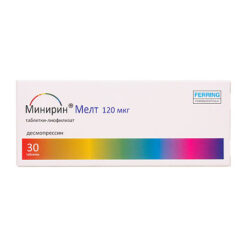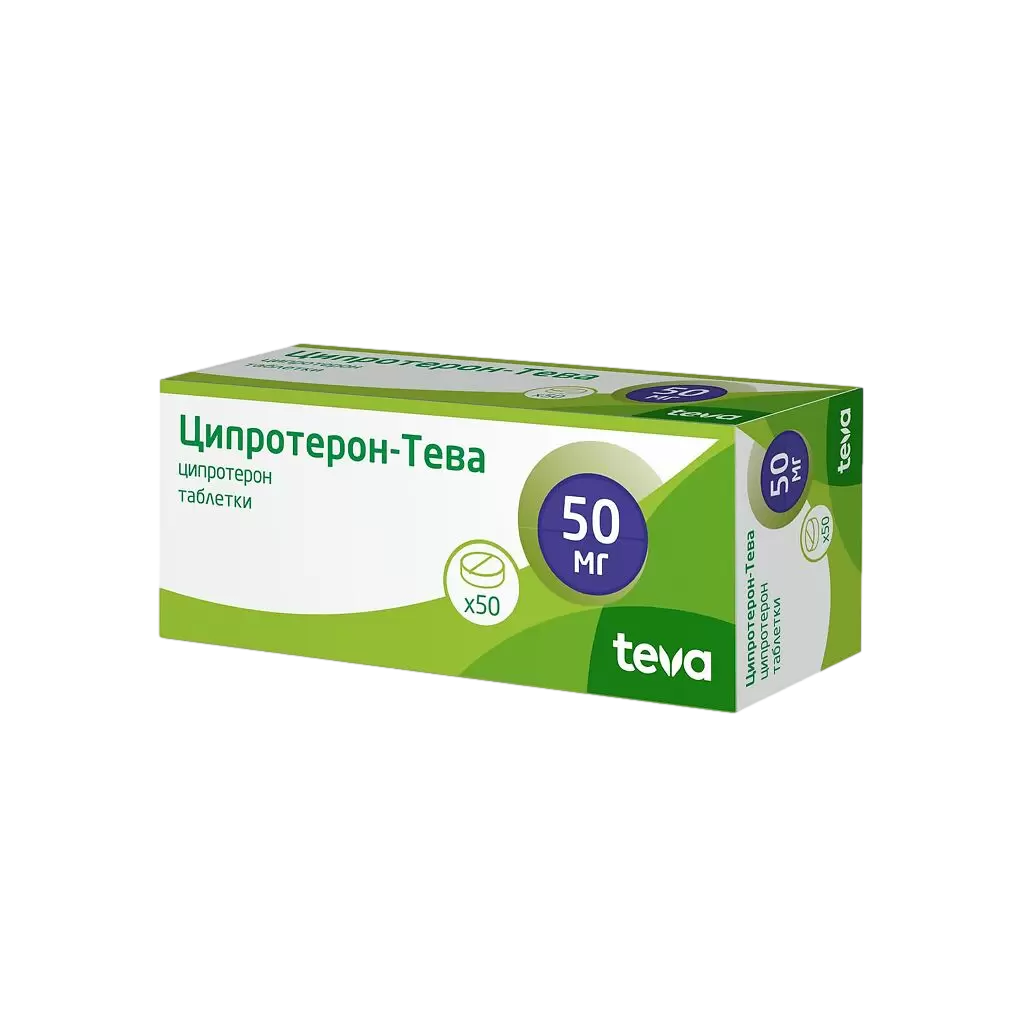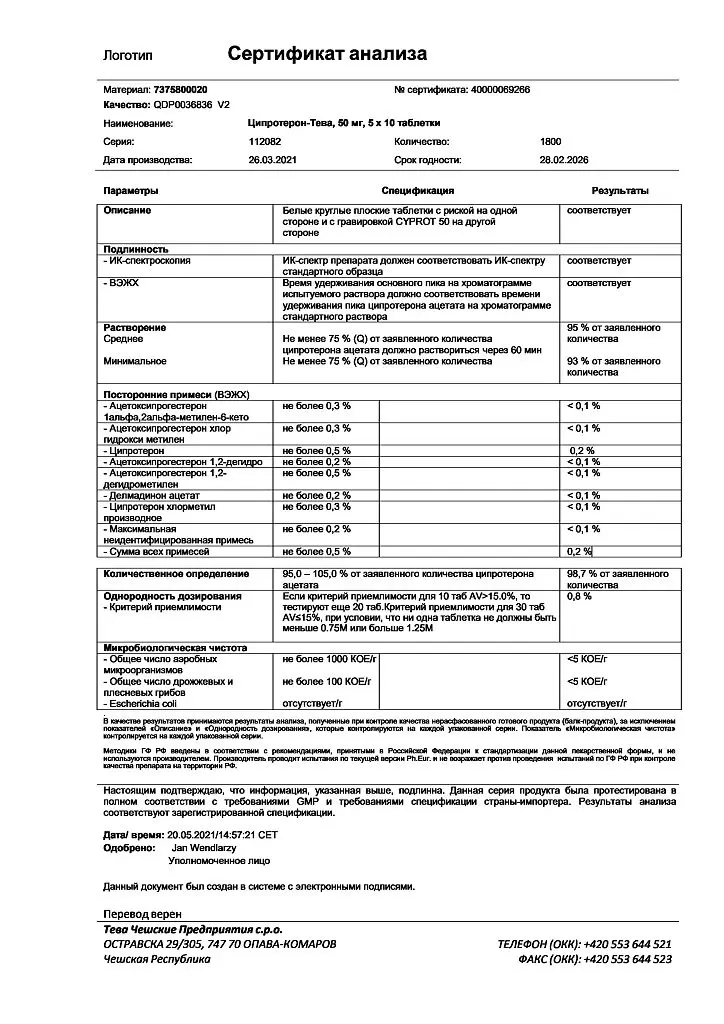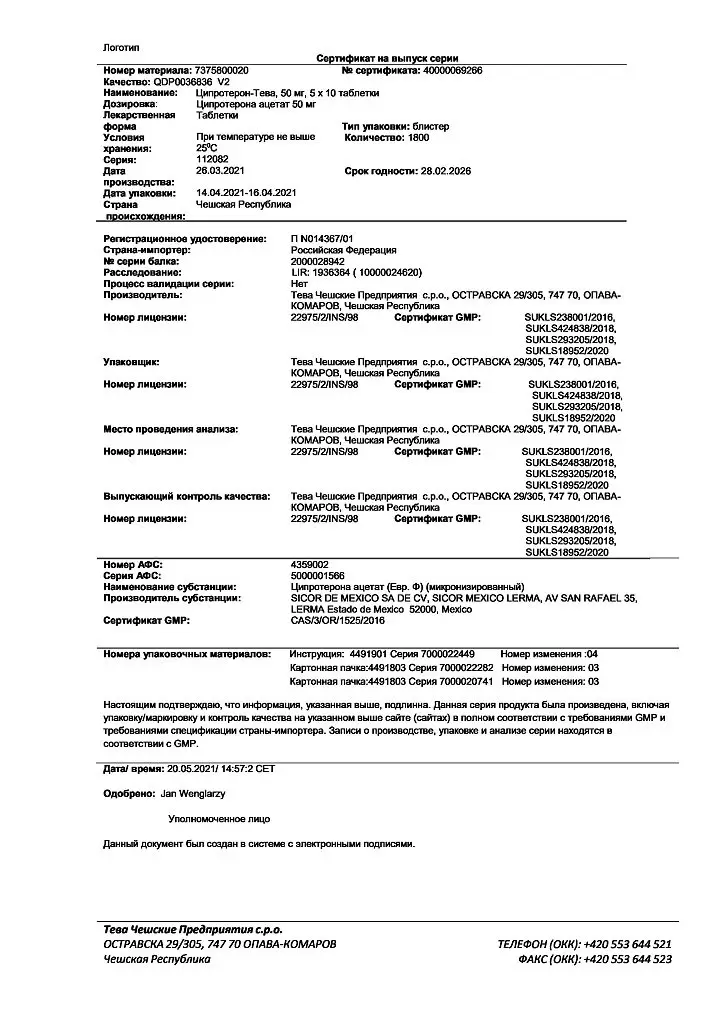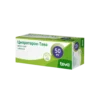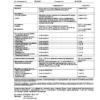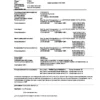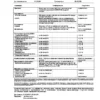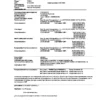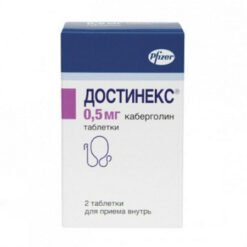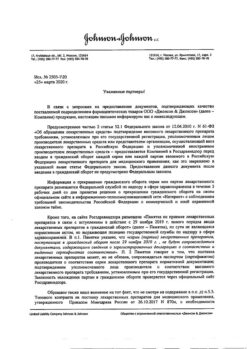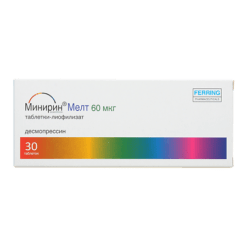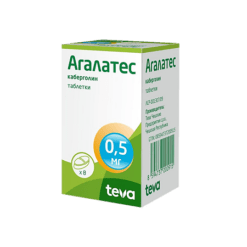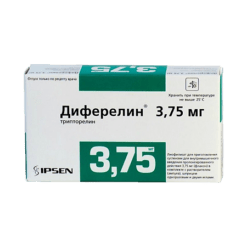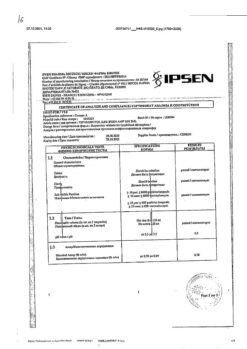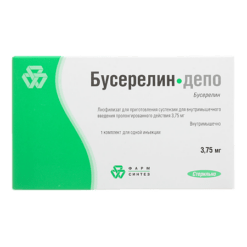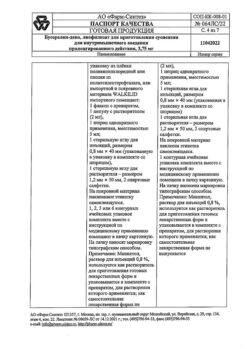Subtotal: €70.53
Cyproterone-Teva, tablets 50 mg 50 pcs
€52.75 €43.96
Out of stock
(E-mail when Stock is available)
Pharmacotherapeutic group: antiandrogen
Pharmacological properties
Pharmacodynamics. Cyproterone has the ability to compete with
tissue androgen receptors in target organs, reducing or completely
eliminating the effects of androgens (both endogenous and exogenous origin) in
target organs of men and women. In addition to the antiandrogenic effect,
cyproterone has a powerful antigonadotropic and progestogenic effect.
In men, while taking cyproterone, there is a weakening of sexual desire and
a decrease in testicular function. Cyproterone reduces or completely eliminates the effects
of androgens on the prostate gland.
The use of cyproterone in women reduces the symptoms of androgenization
regardless of what causes these symptoms – increased
production of androgens or increased sensitivity of receptors to circulating
androgens. Reduces hirsutism, androgenetic alopecia, reduces the secretion of the
secretion of the sebaceous glands of the skin. Cyproterone inhibits ovulation, which causes its
contraceptive effect.
After you stop taking cyproterone, all of its effects disappear.
Pharmacokinetics.
Cyproterone in a wide range of doses after oral administration
is completely absorbed. The absolute bioavailability of cyproterone after
oral administration is about 88%. When taking 50 mg of cyproterone, its maximum
concentration in blood serum after 3 hours is 140 mg / ml. Then there is a
two-phase decrease in concentration (within 24-120 hours). The final
half-life is 43.9±12.8 hours. The total serum clearance of cyproterone is 3.5±1.5
ml/min/kg. Cyproterone undergoes biotransformation in the liver, mainly with the
participation of the CYP3A4 isoenzyme of cytochrome P450. Metabolism occurs mainly
by hydroxylation and conjugation. 15beta-hydroxy derivative is the main
metabolite in human plasma.
Cyproterone is excreted mainly in the form of metabolites with bile and kidneys, part of
cyproterone is excreted unchanged. The ratio of cyproterone in urine and bile
is 3:7. The half-life (T1 / 2) with bile and kidneys is 1.9 days. Metabolites
are excreted from blood plasma at approximately the same rate (T1 / 2 – 1.7 days).
Cyproterone is almost completely bound to plasma albumin. Only 3.5-4%
is in the blood in a free form. Since the connection (non-specific) with
plasma proteins is more important, changes in the content of
sex hormone-binding globulin do not affect the pharmacokinetics of cyproterone.
Due to the long-term nature of the elimination of cyproterone from blood plasma during its
daily intake should be expected to accumulate cyproterone in serum 3 times
greater when using repeated doses in one cycle of treatment
Indications
FOR MEN
Palliative treatment of metastatic or locally advanced inoperable
prostate cancer:
in case of ineffectiveness of treatment and contraindications to treatment with analogues
luteinizing hormone releasing hormone (LHRH);
if surgical treatment is ineffective;
if oral therapy is preferred.
Prevention of the development of the “flash” effect associated with an increase in concentration
testosterone in blood plasma at the beginning of treatment with LHRH agonists.
Treatment of hot flashes that occur with the use of LHRH agonists or after orchiectomy.
Reduced libido during hypersexuality and correction of pathological
deviations in the field of sexual behavior.
FOR WOMEN
Treatment of androgenization symptoms such as:
severe hirsutism after failure of other treatment;
severe androgenetic alopecia, accompanied by severe acne and/or seborrhea.
Pharmacological effect
ATX code: G03HA01
Pharmacotherapeutic group: antiandrogen
Pharmacological properties
Pharmacodynamics. Cyproterone has the ability to competitively bind to
tissue androgen receptors in target organs, reducing or completely
eliminating the effects of androgens (both endogenous and exogenous origin) in
target organs of men and women. In addition to the antiandrogenic effect
Cyproterone has a powerful antigonadotropic and progestogenic effect.
In men taking cyproterone, there is a weakening of libido and
decreased testicular function. Cyproterone reduces or completely eliminates the effects
androgens on the prostate gland.
When using cyproterone in women, the symptoms of androgenization are reduced
regardless of what is the cause of the development of these symptoms – increased
formation of androgens or increased sensitivity of receptors to circulating
androgens. Hirsutism, androgenetic alopecia are reduced, secretion is reduced
secretion from the sebaceous glands of the skin. Cyproterone inhibits ovulation, which causes it
contraceptive effect.
Once you stop taking cyproterone, all its effects disappear.
Pharmacokinetics.
Cyproterone in a wide range of doses after oral administration
completely absorbed. Absolute bioavailability of cyproterone after
oral intake is about 88%. When taking 50 mg of cyproterone its maximum
the serum concentration after 3 hours is 140 mg/ml. Then it is observed
two-phase decrease in concentration (within 24-120 hours). End period
half-life – 43.9±12.8 hours. Total serum clearance of cyproterone – 3.5±1.5
ml/min/kg. Cyproterone undergoes biotransformation in the liver mainly when
participation of the cytochrome P450 isoenzyme CYP3A4. Metabolism occurs mainly
by hydroxylation and conjugation. 15beta-hydroxy derivative – main
metabolite in human blood plasma.
Cyproterone is excreted mainly in the form of metabolites with bile and kidneys, part
cyproterone is excreted unchanged. The ratio of cyproterone in urine and bile
is 3:7. The half-life (T1/2) with bile and kidneys is 1.9 days. Metabolites from
blood plasma is excreted at approximately the same rate (T1/2 – 1.7 days).
Cyproterone is almost completely bound to plasma albumin. Only 3.5-4%
is found in the blood in free form. Since the connection (non-specific) with proteins
blood plasma is more important, changes in the content of globulin binding
sex hormones do not affect the pharmacokinetics of cyproterone.
Due to the long-term nature of the elimination of cyproterone from blood plasma during its
daily intake, one should expect the accumulation of cyproterone in the blood serum by 3 times
greater when repeated doses are used in one treatment cycle
Special instructions
Use strictly as prescribed by the doctor!
The patient should be informed of the need to inform the doctor about the use of any other drug.
Before starting treatment with cyproterone, the patient is recommended to undergo a general medical examination, including determination of the peripheral blood count, urine analysis,
glucose concentration in blood plasma and urine, indicators of the blood coagulation system, blood pressure, body weight, determination of the functional state of the liver and
adrenal glands. Women should undergo a comprehensive endocrinological and gynecological examination, including examination of the mammary glands, ovarian function, cytological examination of cervical mucus, and it is also necessary to exclude pregnancy. With long-term use of cyproterone, these diagnostic
measures are recommended to be carried out every 6 months.
Patients with excess body weight are recommended to consult a nutritionist.
In patients with diabetes mellitus, treatment is carried out under constant medical supervision, because Dosage adjustment of insulin and other
hypoglycemic drugs may be required. Monitoring of liver function in patients with diabetes mellitus should be carried out approximately every 8 weeks.
Rare cases have been described after the use of cyproterone in which life-threatening intra-abdominal bleeding occurred in patients with benign and malignant liver tumors. Treatment with cyproterone should be stopped if there are signs of hepatoma – liver enlargement, pain and a feeling of heaviness in the epigastric region of the abdomen. With long-term use of cyproterone at a dose of 200-300 mg/day, its hepatotoxic effect (jaundice, hepatitis and liver failure) may occur, which in several cases led to death.
Most of the described cases concerned elderly patients with prostate cancer. The hepatotoxic effect of cyproterone depends on the dose and usually develops
after several months of treatment. If the development of hepatotoxicity is suspected, it is necessary to conduct a liver function test. If toxic liver damage is confirmed, the use of cyproterone should be discontinued, except in cases where hepatotoxicity is due to another cause, for example, metastasis of prostate cancer to the liver. In this case, continuation
of treatment is possible provided that the expected benefit of use outweighs
the possible risk.
Cyproterone is not recommended for use in diseases accompanied by exhaustion (cachexia), due to the fact that catabolic reactions in
the body may increase.
Isolated cases of vascular thromboembolism during treatment with cyproterone are described.
However, a cause-and-effect relationship with cyproterone is not installed. However, patients with a history of deep vein thrombosis, pulmonary embolism, myocardial infarction, cerebrovascular accident, or advanced malignancy are at high risk of recurrent thromboembolism during use of cyproterone.
Several reports have reported the occurrence of meningioma with long-term use of cyproterone. dose more than 25 mg/day. If the patient
is found to have meningioma, use of cyproterone should be discontinued.
Very rarely, shortness of breath may occur when using the drug in high doses. This may be due to the stimulating effect of progesterone and synthetic progestogens on respiration, which is accompanied by hypocapnia and compensatory respiratory alkalosis. Symptoms disappear after discontinuation of cyproterone without special treatment.
During the use of cyproterone, it is necessary to regularly evaluate the state of adrenocorticosteroid function due to the fact that in experimental
studies using high doses of cyproterone, its decrease was noted due to the manifestation of the cortico-like action of cyproterone.
Patients with rare hereditary diseases such as galactose intolerance, deficiency lactase, malabsorption of glucose-galactose
the drug should not be taken.
When using cyproterone in men for several weeks, spermatogenesis is often suppressed due to the antiandrogenic and antigonadotropic effect of
cyproterone – the number of sperm decreases and the volume of ejaculate decreases.
Sexual desire and potency are also very often reduced. Spermatogenesis gradually recovers over 3-5 months. after discontinuation of cyproterone, in some patients
spermatogenesis can be restored within 20 months. It is not yet known whether spermatogenesis can be restored after a very long period of treatment. In
10-20% of cases, men experience gynecomastia, which usually decreases with discontinuation or reduction of the dose of the drug.
In men of reproductive age, before starting treatment with cyproterone, it is necessary to
evaluate the spermatogram. During treatment with the drug, the decrease in spermatogenesis occurs gradually, so cyproterone cannot be used as a male contraceptive.
With simultaneous consumption of alcohol, patients with pathologically increased sexual desire may experience a decrease in the effect of cyproterone therapy. In
patients with alcoholism, treatment with cyproterone for hypersexuality and pathological
deviations in the field of sexual behavior is usually ineffective.
Since sexual and androgenic activity are not identical, suppression of androgenic activity is not always accompanied by suppression of sexual desire.
Comprehensive treatment is required using psychotherapeutic and sociotherapeutic methods in close collaboration with the patient’s wife. When appropriate measures are taken, the use of cyproterone for the purpose of suppressing sexual activity can give a positive result.
In patients with organic brain lesions or mental illnesses with deviations in sexual behavior, cyproterone has no clinical effectiveness.
In women, the use of cyproterone should only be carried out under the supervision of an experienced
doctor – a specialist in the field of hormonal therapy.
Cyproterone should not be used in young women who have not yet developed The formation of a normal menstrual cycle has not completed.
Before starting treatment, pregnancy should be completely excluded. If menstrual bleeding stops during treatment, the drug should be discontinued until pregnancy is completely ruled out. During treatment with the drug, pregnancy should not occur. In this regard, women of reproductive age should always use effective methods of contraception when taking cyproterone. It is recommended to take a combined estrogen-progestogen PC in the minimum possible dose of ethinyl estradiol 30-35 mcg.
When taken in combination with a PC, you should read the appropriate instructions for medical use.
The use of cyproterone in women suffering from diseases that can aggravate the course of pregnancy (epilepsy, chorea, otosclerosis, multiple sclerosis, porphyria, diabetes mellitus and arterial hypertension) should only be carried out under the supervision of a physician, regardless of how cyproterone is used, as monotherapy or with PC.
In patients with gastrointestinal disorders accompanied by vomiting
and/or diarrhea, it is not always possible to prevent pregnancy when using PC. Despite this, treatment should not be stopped. Until the end of the treatment cycle, it is recommended to use barrier methods of contraception (condoms) as additional contraceptive measures. If there is no menstrual bleeding during a week-long pause in taking the drug, the drug should be discontinued until pregnancy is ruled out.
Typroterone should not be stopped if bleeding in the form of “smearing” is observed outside the week-long break period. In case of heavy and repeated bleeding, a gynecological examination is necessary.
The use of cyproterone in combination with estrogens increases the risk of thrombosis. This fact must be taken into account when using cyproterone in women requiring surgical treatment. It is recommended to interrupt treatment with cyproterone 6 weeks before the planned surgery. During periods of prolonged bed rest, cyproterone should be suspended.
Women at the beginning of treatment with cyproterone very often experience tenderness or a feeling of tension in the mammary glands or their enlargement, irregular menstrual bleeding or amenorrhea. A decrease in sexual desire is often observed.
Due to a decrease in the function of the sebaceous glands, dry skin may be noted.
There was no negative effect of cyproterone on the fertility of patients after cessation of treatment.
Patients who have not reached puberty (the adverse effect of cyproterone on the growth of the patient and the formation of his endocrine system cannot be excluded) should not take cyproterone.
Given the medical and social significance of the manifestation effects of cyproterone, it is recommended to obtain informed consent from the patient before starting treatment.
Influence on the ability to drive a car and operate machinery
When using cyproterone, care must be taken when driving
vehicles and performing activities that require increased concentration and speed of psychomotor reactions, due to the fact that
cyproterone can cause a feeling of fatigue, fatigue, dizziness (especially in the first weeks of treatment).
Active ingredient
Cyproterone
Composition
1 tablet contains: active ingredient cyproterone acetate 50.00 mg;
excipients: potato starch 55.30 mg, lactose monohydrate 98.43
mg, crospovidone 5.77 mg, sodium lauryl sulfate 0.97 mg, hyprolose
(hydroxypropylcellulose) 3.83 mg, talc 9.00 mg, magnesium stearate 1.13 mg, silicon
colloidal dioxide 0.57 mg.
Pregnancy
The drug Cyproterone-Teva is contraindicated for use during pregnancy.
If it is necessary to use cyproterone during lactation, it is necessary to decide
question about stopping breastfeeding.
It cannot be ruled out that men may experience
abnormal sperm, which can cause fetal developmental abnormalities.
Men and women while taking Cyproterone-Teva should
use effective methods of contraception.
Contraindications
Hypersensitivity to cyproterone or any other component of the drug;
liver diseases with impaired liver function, liver failure, syndrome
Dubin-Jones, Rotor syndrome, benign and malignant liver tumors,
including a history (except for prostate cancer liver metastases);
malignant tumors (except prostate cancer); idiopathic jaundice
or persistent itching during pregnancy (history); herpes in pregnant women (history);
cachexia (except for inoperable prostate cancer); severe chronic
depression; thrombosis and thromboembolism, including a history; severe form of sugar
diabetes complicated by angiopathy, including retinopathy; sickle cell
anemia; meningioma, including a history; contraindications must be taken into account
for oral contraceptives (when used simultaneously with cyproterone);
congenital galactose intolerance, lactase deficiency, syndrome
malabsorption of glucose-galactose; children under 18 years of age; pregnancy; period
breastfeeding.
With caution
Diabetes mellitus of mild to moderate severity, risk factors for development
thromboembolism, epilepsy, chorea, otosclerosis, multiple sclerosis, porphyria (for
patients with manifestations of androgenization).
Side Effects
The most common adverse reactions in patients taking cyproterone are
are decreased libido, erectile dysfunction and suppressed spermatogenesis.
The most serious adverse reactions are hepatotoxicity, the appearance of
benign and malignant tumors, which can lead to intra-abdominal bleeding, and vascular thromboembolism.
Adverse reactions such as abdominal pain, nausea, attacks of general apathy and anxiety most often appear in the 2-6th week of treatment. Usually these symptoms go away quickly.
The incidence of side effects is classified according to recommendations
World Health Organization: very often – at least 10%; often – at least 1%, but less than 10%; infrequently – not less than 0.1%, but less than 1%; rarely – not less than 0.01%, but less
0.1%; very rarely – less than 0.01%, including isolated cases; frequency unknown (cannot estimate frequency from available sources).
From the respiratory system, chest and mediastinum: very rarely – shortness of breath.
On the part of the organ of hearing and balance: very often – vertigo.
From the blood and lymphatic system: isolated cases – anemia.
From the cardiovascular system: isolated cases – thromboembolism, frequency unknown – thrombosis, pulmonary embolism, myocardial infarction, increased blood pressure.
From the skin and subcutaneous tissues: infrequently – skin rash; isolated cases –
dry skin, changes in hair growth.
From skeletal muscles, bones and connective tissue: rarely – muscle weakness; isolated cases – osteoporosis.
From the digestive system: often – abdominal pain, nausea; very rarely –
jaundice, hepatitis, liver failure; isolated cases – intra-abdominal
bleeding associated with a benign or malignant liver tumor.
From the nervous system: very often – anxiety, headache, dizziness, depression, apathy, depressed mood; isolated cases – meningioma, frequency unknown – cerebrovascular accident.
From the endocrine system: frequency unknown – suppression of adrenal cortex function.
From the reproductive system and mammary glands: very often – decreased sperm count, decreased ejaculate volume, male infertility, azoospermia, erectile dysfunction, gynecomastia, tenderness or a feeling of tension in the mammary glands or their enlargement, irregular menstrual bleeding or amenorrhea; often – decreased libido.
Allergic reactions: rarely – hypersensitivity reactions.
Other: very often – weight gain or loss, feeling tired, increased fatigue, sweating, hot flashes
Interaction
The antiandrogenic effect of cyproterone is enhanced by its simultaneous use
with gonadotropin-releasing hormone (GnRH) agonists.
Under the influence of cyproterone, the initial increase in testosterone production by GnRH agonists is reduced.
When used simultaneously with PCs, the risk of developing thrombosis and vascular thromboembolism increases.
With simultaneous use of cyproterone with thiazolidinediones, including
pioglitazone and rosiglitazone, there may be a need to adjust the dose of these hypoglycemic drugs due to an increase in their concentration in
blood plasma.
When used simultaneously with insulin, its clinical effectiveness may change, which may require dose adjustment.
Ethanol reduces the clinical effectiveness of cyproterone in patients with alcoholism.
It can be expected that ketoconazole, itraconazole, clotrimazole, ritonavir and other strong inhibitors of the CYP3A4 isoenzyme may suppress the metabolism of cyproterone. C
on the other hand, inducers of the CYP3A4 isoenzyme, such as rifampicin, phenytoin and
preparations containing St. John’s wort may reduce the concentration of cyproterone.
In vitro studies have shown that at high therapeutic doses of cyproterone (300
mg/day) possible inhibition of cytochrome P450 isoenzymes CYP2C8, CYP2C9, CYP2C19, CYP3A4 and CYP2D6
Associated with the use of HMG CoA reductase inhibitors (statins), the risk of developing myopathy and rhabdomyolysis may increase with simultaneous use of high
therapeutic doses of cyproterone. Statins are metabolized primarily by the CYP3A4 isoenzyme (they have the same metabolic pathway as cyproterone).
Overdose
In case of overdose, if the patient is conscious and without spontaneous vomiting, vomiting should be induced.
It is necessary to use symptomatic therapy with constant monitoring of the patient and vital functions.
Storage conditions
Store at a temperature of 15-25°C in a dry place, protected from light and out of reach of children.
Shelf life
5 years.
Manufacturer
Teva Czech Enterprises s.r.o., Czech Republic
| Manufacturer | Teva Czech Enterprises s.r.o., Czech Republic |
|---|---|
| Brand | Teva |
| Shelf life | 5 years. |
| Storage conditions | Store at a temperature of 15-25°C in a dry, dark place and out of the reach of children. |
| Active substance | Cyproterone |
Related products
Buy Cyproterone-Teva, tablets 50 mg 50 pcs with delivery to USA, UK, Europe and over 120 other countries.

